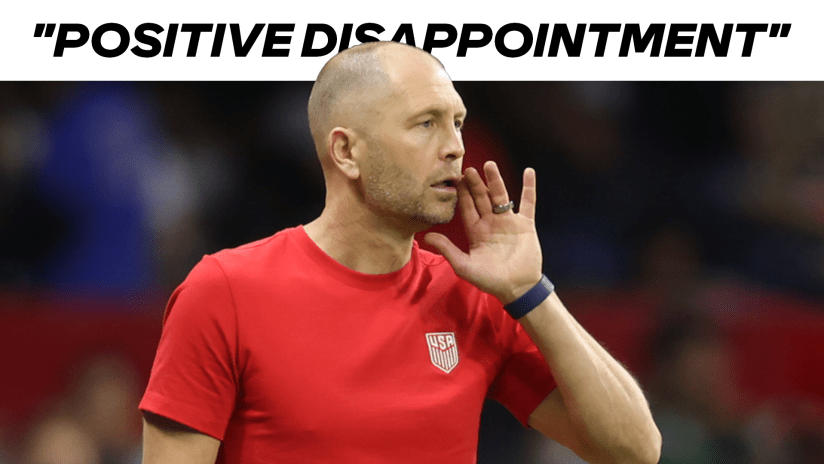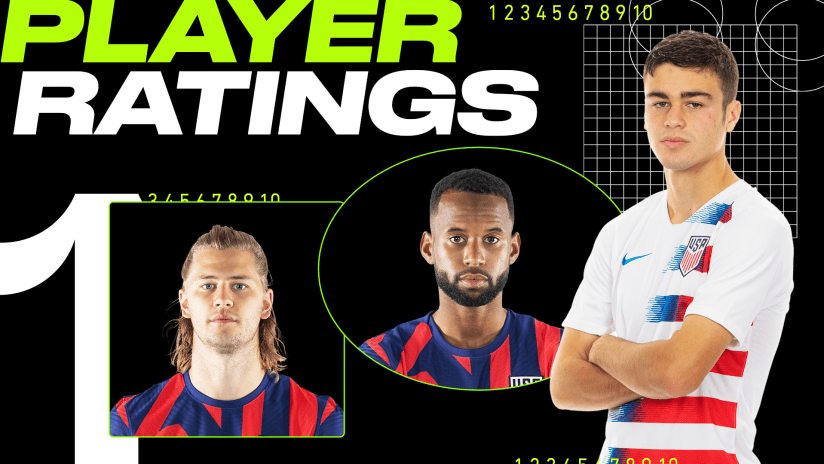Gregg Berhalter went for it, and you’ve got to give him credit for that. The US men’s national team have taken a point out of the Azteca in the past – they did it last cycle, and the cycle before that, as well as way back in the 1998 cycle – so coming out of a World Cup qualifier with a 0-0 result at the legendary stadium is not a first. There was no new ground broken in that sense in the USMNT’s scoreless draw in Mexico City on Thursday night.
The way the US played, though? That broke new ground. They created the three best chances of the game, and it wasn’t because of set pieces or pure counter-attacking prowess. It was because they were better on the ball and better off the ball, and because the players on the field were better tactically and, I’d argue, technically than their El Tri peers. There was no question who the protagonists in the game were. Berhalter didn’t set his group up to survive, he set them up to win.
So yeah, they went for it. They didn’t go to the Azteca to grind out a point; they went there to come back with all three. They went out there to prove that they were the better team, and for 80 minutes they pretty thoroughly proved that they were (the final 10 minutes was proof they still need work on the 5-4-1 and that Berhalter should’ve brought more fullbacks).
They also proved that soccer can be a cruel game, one where the most important moment – the moment the ball is kicked at the net – is also naturally a high-variance moment. That is the data-friendly way of saying that Christian Pulisic, Jordan Pefok and, to a much lesser extent, Yunus Musah would probably want those chances back.
Ooof.
Anyway, if you’re a US fan, you should be proud of the way this team played. They stayed on the front foot, put Mexico under pressure throughout, and even problem-solved some defensive issues on the fly (through the first 25 minutes nobody was rotating back to cover in behind when Antonee Robinson pushed up, which led to a yellow on Miles Robinson and a number of potentially profitable El Tri moments, which eventually disappeared as Pulisic, Kellyn Acosta and Tyler Adams sorted things out).
It was one final touch away from a masterclass. And it might’ve come at a really high cost.
Look at these quotes from Pulisic and Berhalter:
“It was definitely a tough game, it took a lot out of us,” Pulisic said.
“The group is jazzed up, they’re psyched. It was a good performance. We wanted to be the first team to beat Mexico at the Azteca and we fell a little bit short but the mood’s not down, it’s the opposite,” Berhalter said afterward. “We know we’re going home, we know we’re playing in front of a great crowd in Orlando and we’re excited about that. The spirits are up; I can’t say enough about the effort of the guys, to expend that much energy at altitude like that was phenomenal.”
The point I’ve been making for the past two weeks: expending that much energy at altitude is a hell of a gamble to make three days before a game that is more important than the trip to the Azteca was. Beating Panama at home remains the key to qualifying, though Panama unexpectedly dropping points on Thursday thanks to a 1-1 draw with Honduras does extend the margins somewhat.
So it was a wonderful point the US took in Mexico, and a memorable performance (you could say the same for the US’s last qualifier at the Azteca, by the way), but it really didn’t gain this team much.
And it cost a ton. Musah was dead on his feet by the end, as was Pulisic. Adams and Jedi both looked like they had more to offer, but logging those minutes at altitude (80 for Adams, 90 for Jedi) and then going out there into a must-win on short rest is… a lot. A whole damn lot.
Fatigue like that travels. Just look at how MLS teams fared in their recent short-turnaround efforts in the league following midweek Concacaf Champions League at altitude. It hasn’t been pretty.
Beyond the energy issue, four US players entered the game on a yellow card and thus one clumsy challenge away from suspension. DeAndre Yedlin and Tim Weah obliged, each absolutely earning their respective yellow, which means they’re suspended for the Panama game. Yedlin’s replacement, Shaq Moore, had to hop on a plane and fly to Orlando yesterday after Reggie Cannon was confirmed out with what is hopefully the only case of COVID-19 in camp. Weah’s replacement is likely Paul Arriola or Jordan Morris – both very good players, but neither as consistently dangerous as Weah’s been over the course of qualifying.
The US will be heading into the most important game of the cycle at less than full strength. It’s not ideal.
We’ll talk about what it’ll look like/what they should do below, but let’s finish off our Mexico discussion first with some bullet points:
• The US are 6W-0L-1D with one goal conceded (+14 goal differential) when Walker Zimmerman and Miles Robinson start together in central defense. It’s safe to say they have earned the right to be the No. 1 pairing.
• Acosta had maybe his best game of the Ocho as a No. 8, I think? He’s generally been much better as a No. 6, in a role that both emphasizes his distribution and gives him clearer defensive responsibilities. As an 8 you have to find the game and Acosta doesn’t always do that, and even on Thursday there were moments like that – Acosta was completely lost after an Adams turnover in the 78th minute that led to a Chucky Lozano shot from the top of the box.
But more often than not he made the defensive interventions he needed to, and his distribution was excellent, even if his dead-ball delivery was a level or two lower than he’d provided against Honduras in the last window.
• Musah and Adams had the types of performances we’ve come to expect from them. Mexico didn’t even look at trying to build through the middle until the US legs started to go, around the 75th minute or so, and those two guys are the biggest reasons why.
• El Tri’s gameplan of hitting big diagonal switches to either attack the US fullbacks 1v1 or get into space behind was a good one, but Jedi and Yedlin mostly held up, and after the first 20 minutes the US attackers did a much better job of preventing those switches in the first place.
• Zack Steffen struggled with his early distribution, but otherwise did not put a foot wrong, and made the saves he had to. It was an assured, veteran performance from him.
The last time I saw a US player dribble an entire team like this it was 14-year-old Freddy Adu against some unfortunate South Koreans at the 2003 U-17 World Cup. I’ve never seen it at the senior level, and certainly not on a stage like the Azteca for a World Cup qualifier.
I’m not a tekkers guy – give me a pretty one-touch passing sequence over individual skill any day – but holy sh*t. That was absurd.
It also came just moments after Reyna had made the absolute right play by putting it on a platter for Pefok, following a breath-taking ball from Acosta:
Reyna hasn’t always done that. He’s had a selfish streak since his youth days, and we’ve seen that from him before for the US at the senior level. Just recall the Nations League semifinals when he didn’t make the above pass to give Josh Sargent a tap in.
Even though Pefok missed, I’m glad Reyna played him that ball. And I hope he does the same again next time, no matter who the No. 9 is.
• Man, was Weston McKennie missed in this one. His ability to inject chaos into opposing defensive shapes would’ve wrecked this Mexico side, and obviously we’ve seen him dominate El Tri on restarts before.
Berhalter’s got to make a clear-eyed assessment of who has enough in the tank to go out there vs. Los Canaleros and get the job done. It’s ok to bring Pulisic off the bench if he’s gassed – he’s been better as a sub in qualifying, anyway. If one of Zimmerman or Miles Robinson is cooked, Aaron Long has looked good enough over the past month to step in and do the job. Musah can’t go? Then maybe both Reyna and Luca de la Torre start in central midfield with Adams.
And if Adams can’t go… You know what? I don’t have the mental or emotional energy to live in a world where Tyler Adams isn’t fit enough to play from the start on Sunday night (7 pm ET | FS1, UniMas, TUDN). He’s got to go.
But overall, you get my point here: The questions Berhalter’s facing are not tactical, but rather rotational. The US tactics have been good, and we know that, in Panama, they’ll face a fairly disciplined low-block team who will do their level best to rob the game of any rhythm. The US will have to be able to play through that, and to turn the chances they get into goals in a way that they didn’t manage against Mexico.
Grabbing a few more set-piece looks would help, too.

• I’m sure Reyna wants to start, but given his fitness issues it feels more prudent to bring him off the bench for the final 35 minutes, either on the wing or as a No. 8.
• Ricardo Pepi had a nice lay-off on the build-up to Pulisic’s chance but didn’t do much else. Pefok missed his big chance, doesn’t offer much in the build-up and doesn’t defend well.
So now it’s Jesus Ferreira’s turn at the No. 9.
• Moore probably has to start, right? The only other options are guys like Acosta, Paul Arriola and Cristian Roldan. They’re all guys who have occasionally played at right fullback, while Moore is an actual right fullback.
He was very poor in his previous start in qualifying, which was at Panama. This feels like a nice bit of symmetry and a shot at some redemption.
• A win or draw against Panama would guarantee the US finish no lower than fourth place, and thus earn them a trip to Qatar either directly for the World Cup in November, or for the playoff against the Oceania representative in June (most likely New Zealand).
• If the US win and Costa Rica drop points at El Salvador, the US are officially qualified. If they draw and Costa Rica lose, they’re officially qualified. Just getting a better result than the Ticos does the trick.
• If the US, Costa Rica and Mexico all win, then qualifying would officially come down to the final day, with the US just needing to avoid the type of loss that would wipe out their substantial goal differential margin over the Ticos.
• If the US lose, then Monday and Tuesday are a barren hellscape and the USMNT fanbase needs to pray for a result in San Jose on Wednesday.
This Panama game is, in short, the most important game the US have played since that fateful night in Couva. Berhalter’s got to make sure he picks a team that plays like it.














